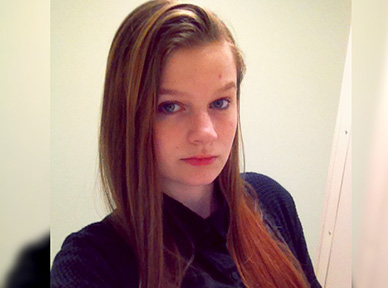This article is excerpted from an essay that appears in T&W’s book, Third Mind: Creative Writing through Visual Art, edited by Tonya Foster and Kristin Prevallet (2002). It was originally printed in Teachers & Writers Magazine, Volume 33, Issue 4, March/April 2002
It was only after several years of using art to launch students’ poetry (and my own) that I learned the process had a formal name—”ekphrastic poetry” (or, alternately, “ecphrastic”)—from the Greek, meaning poetry that takes its inspiration from visual art. In its earliest, most-restricted sense, ekphrasis referred to the verbal description of a visual representation, often of an imagined object such as the shield of Achilles in the Iliad. With its principle of ut pictura poesis (poetry as a speaking picture and painting as mute poetry), Horace’s Ars Poetica expressed the ekphrastic ideal of giving voice to painting. From Ben Jonson to William Blake to the Romantics, many poets, most famously Keats with his urn and Shelley with his fallen statue, have allowed art to tease them “out of thought.” Rainer Maria Rilke, the Surrealists, W. B. Yeats, Marianne Moore, W. H. Auden, and William Carlos Williams continued the tradition in the twentieth century. Nowadays, as semioticians and other literary theorists try to resolve the temporal/spatial dualities of text/image, one promising sign is a literary journal, appropriately entitled Ekphrasis, which publishes the work of the many contemporary poets who continue to find inspiration in visual art.
It seems that works of art, in and of themselves, have the power to create creativity. According to poet Edward Hirsch, looking at a work of art is like looking into the act of creation. “Works of art,” he says, “initiate and provoke other works of art; the process is a source of art itself.”(1) From the outset, engagement with visual art requires something different from engagement with the day-to-day world. Art gives us imagery—images that are representational rather than real. Art requires leaps of perceiving and experiencing. Like viewers of René Magritte’s Ceci n’est pas une pipe, we are suddenly confronted with something that is, yet is not, what it seems. This otherness or detachment from the rest of the world-which the philosopher Suzanne Langer defines as characteristic of every genuine work of art-may be one reason why art can provide such a wonderful stimulus to writing. As Langer aptly puts it: “Sometimes, in the presence of great art, attention to the actual environment is hard to sustain.”(2) Painting, she explains, creates a sense of “virtual space,” or semblance; we experience it the way we experience a dream, abstracted from ordinary reality, yet vivid and real, alive in its own terms. Henri Matisse’s view that “a drawing must … bring to life the space which surrounds it”(3) is echoed by many artists. This virtual space is a living space, capable of drawing the viewer into a meditative or dream state where eye, heart, and mind journey together.
The long looking and close attention required to enter into an artwork is strikingly illustrated by Rilke’s Letters on Cézanne. These letters by the poet, written to his wife Clara and composed in Paris in 1907 when he was paying daily visits to a salon exhibiting Paul Cézanne’s work, reveal his conviction that art demands participation by the viewer, not just intellectual understanding. That the process deeply penetrated Rilke’s psyche can be seen in some of the phrases he used to describe colors in Cézanne’s paintings. For Rilke, Cézanne “so incorruptibly reduced a reality to its color content that that reality resumed a new existence in a beyond of color.”(4) Instead of language that labels, Rilke gives us language that responds: a “deeply quilted blue,” a “listening blue,” a “self-contained blue,” and more-all coming from a realm of words far removed from such tags as indigo or cerulean. In the paintings of Cézanne, Rilke found a way toward the language of”pure objective telling” that he sought in his poetry; as he said of the fruits Cézanne painted, they “cease to be edible altogether, that’s how thing-like and real they become.”(5)
Ekphrastic poetry involves the writer-viewer in a variety of stances toward the art: one may describe, address, or reflect upon the subject of the work. But perhaps the most useful of these stances, especially with painting, is “entering”— which, as poet and critic John Hollander explains, encourages us to make the spirit and space of the work of art our own. Czeslaw Milosz’s poem “Realism,” which begins, “We are not so badly off if we can admire Dutch painting,” takes the reader on a journey reminiscent of Keats’s negative capability. Midway into the Milosz poem, the speaker states, “Therefore I enter those landscapes,” before joining the human figures in the scene, “becom[ing] one of them who vanished long ago.” This process of entering and becoming is so fundamental to engaging in a work of art that it almost seems too basic to point out, save to note that the intense, absorbed state of mind that one has when looking at art is similar to the intense focus of writing. As we step inside the artwork and let its space become our space, we more easily get into that state that poet Jane Hirshfield calls “flow”: “the moment willed effort falls away and we fall utterly into the object of our attention.”(6)
An astonishing variety of strategies for ekphrastic poetry can be found in the work of contemporary poets. These can go beyond the examination of a single work; many poets find the life or oeuvre of a painter just as intriguing as the paintings themselves. Mark Strand and Charles Simic have each devoted an entire volume of poetry to a single artist—Edward Hopper and Joseph Cornell, respectively. Lisel Mueller, in her poem “Monet Refuses the Operation,” evokes well-known images from Monet’s paintings as well as the artist’s philosophy of flux and flow. Monet firmly informs his eye doctor that he has no intention of “correcting” his vision and abandoning “haloes / around the streetlights in Paris” in order to embrace “fixed/ notions of top and bottom” or “return to a universe/ of subjects that don’t know each other.” After all, he says, it had taken “all my life/ to arrive at the vision of gas lamps as angels.” In Text and Contexts, Geoffrey and Judith Summerfield explain how writing from a persona or an assumed role can help the writer make new discoveries and connections. “The framework of the role … [its] vicariousness … is perhaps its greatest virtue. No personal confession is involved. But the very detachment promotes, paradoxically, greater intensity and concentration of existential presence,’ of personal truth.”(7) Monet’s persona becomes a mask through which Mueller expresses a kind of artistic or philosophical manifesto.
Many other poets use carefully selected details from an artist’s life in their poems. Stanley Kunitz’s “The Crystal Cage,” for example, addresses the artist Joseph Cornell directly: “Three days you fasted/ to bring you, angels.” After a catalog of symbols and images from Cornell’s work, Kunitz has the artist slowly ascend a bell tower of imagery until the last lines (“What if, below,/ your twisted brother is calling?”) pull Cornell back to the reality of the handicapped brother he cared for. Alicia Ostriker’s four-part poem “Caravaggio: The Painting of Force and Violence,” draws the viewer-reader into a meditation on violence in the work of “an ignobly modern man/ a quick man with a sword.” In The Art of Loss, Myrna Stone weaves narrative details of the lives of Botticelli, van Gogh, and Degas into poems about these artists’ work. Botticelli’s grief over Savonarola’s execution, van Gogh’s last days as a guest of Dr. Gachet, and Degas’s mourning for Rouart form the background of poems that also guide the reader’s eye through the canvases in question. Poet Patricia Hooper, in “Monet’s Garden,” uses quotes from the artist’s diary to reveal the almost clinical interest he took in the change of colors in his dying wife’s complexion.
The encounter with art can also provide poets with an imaginative substratum through which difficult personal subjects can surface. In a recent conversation, Linda Nemec Foster discussed how Gerrit Beneker’s Provincetown in Winter, 1918, a subdued painting of boats and sky, enabled her to write, finally, about the deaths of her mother’s two sisters, which came before her mother was born. The painting’s date helped her make the connection between the time of her mother’s conception (“Half-way into the continent, in a place of factories/ not boats, my mother is being conceived/ by her immigrant parents”) and the evocative, almost vanishing boats “leaning into each other/ as if in unmarked graves. The sky,/ gray and calm, waiting to be born.”(8) Bob Hicok’s poem “Rivera’s Golden Gate Mural,” in which a father and daughter view Rivera’s artwork together, reveals much about the mural and its two viewers. What the child likes—what interests her, what she asks or doesn’t ask about—helps the reader both to see details in the mural and to learn about the fragility in the father/daughter relationship. The girl wants to know, finally, about “the tree of Life and Love,” and if her father loved her mother, to which the speaker lies and answers, “Yes.”
The fact that the actual images described in ekphrastic poetry are seldom present to the reader can create a very lively triangle among the artwork and poet, poet and reader, and the reader and the art described in the poem. And while the contemporary poet may fulfill the traditional ekphrastic goal of making the reader “see,” the poem frequently goes beyond this, embracing the writer’s associations or concerns and even reflecting on its own being as a poem. One extraordinary example of this is John Ashbery’s “SelfPortrait in a Convex Mirror,” a 16-page meditation on the painting by Parmigianino of the same name, in which the poet examines and seems to take delight in multiple facets of art-poet-readertext connections. The poem alternately addresses the artist (by his first name, Francesco) and the reader; includes visual details of the painting as well as critical commentary and facts about the painting’s history and Parmigianino’s life; and lets us know when the poet first saw it and where the painting now hangs. But primarily it takes the reader on a luxurious excursion through memory, reflections on the soul expressed in art, and the writer’s meditations upon himself and the poem he is writing. The elusive nature of the whole endeavor keeps cropping up as Ashbery invites all the contradictory impulses, thoughts, and associations evoked by the painting to surface and contend with one another. Near the end, the poem itself becomes suspect:
…the way of telling …somehow intrude[s]. twisting the end result Into a caricature of itself. This always Happens, as in the game where A whispered phrase passed around the room Ends up as something completely different. (9)
Elizabeth Bishop’s “Poem,” by contrast, is an example of a poet trying to capture precisely what she sees—in this case, in a work of art that might not be regarded as fine art. Bishop is not alone in finding inspiration in amateur painting of common artifacts. “Outsider” art and folk installations have sparked poems by Mark Doty (“Dickeyville Grotto”) and Sandra McPherson (“Outsider: Minnie Evans” or “Reposoir: Four Legends for Mose Tolliver’s Flowering Tree”)—to name just a few contemporary poets who understand that the so-called “quality” of the art does not determine the writing. As Marcel Duchamp says, “Art is not about itself but the attention we bring to it.” Through attentiveness to the artwork’s exact size, color, detail, and purpose, Bishop teaches us that nothing is unworthy of attention, not even a modest painting that “never earned any money.” About halfway through the first page of the poem, she enters the scene, declaring “The air is fresh and cold,” before arriving at the sudden realization, “Heavens, I recognize the place, I know it!” This recognition returns her to the “literal small backwater” where both she and the unknown artist lived, their memories “cramped/ dim, on a piece of Bristol board,/ dim, but how live, how touching in detail.”
Many encounters with works of art engender similar shocks of recognition. Stephen Dunn initiates his poem “Slant,” a wry take on Mark Tansey’s painting of a cow in a room looking at the unveiling of painting of a cow in a field, with a description of a peaceful, fairly ordinary day. But the disjuncture prompted by this hyper-real painting jolts the speaker, who suddenly feels as if he’s been “invited/ into the actual, someplace/ between the real and the real.” Perhaps the most famous poem that conveys this shock of recognition is Rilke’s “Archaic Torso of Apollo,” a meditation that ends with an injunction: “You must change your life.” A more recent example of artistic-poetic shock value is Jim Daniels’s collection of poems based on paintings by Francis Bacon. Daniels’s vernacular ekphrasis seems less inclined to capture visual detail than to get at the emotion or existential truth of the paintings. With lines such as “we got an amusement ride called/ the electric chair—how about you?” or “I’m part buffalo, part/ human virus. I wear a red tie/ to hide the fat pill of my sick heart,” Daniels creates and enters personae that are extreme, often vile, and hard to watch—intuitive and fascinating poetic doppelgangers of Bacon’s tortured figures.
This survey of ekphrastic writing by contemporary poets barely scratches the surface of a genre as varied as the writers who employ it. Nevertheless, I hope it points to the rich interactions and crossovers that occur when word-folk try to express their encounters with the work of image-folk. In the words of writer and teacher Anne Berthoff, “visualizing, making meaning by means of mental images, is the paradigm of all acts of mind. Students who learn to look and look again are discovering their powers.” (10)
- Transforming Vision: Writers on Art. Selected and introduced by Edward Hirsch. (Boston: The Art Institute of Chicago/Little, Brown, 1994), p. 10.
- Suzanne Langer, Feeling and Form (New York: Charles Scribner’s Sons, 1953), p. 81.
- Ibid, p. 84.
- Rainer Maria Rilke, Letters on Cezanne (New York: Fromm International Publishing,1985), p. 65.
- Ibid, p. 33.
- Jane Hirshfield, Nine Gates: Entering the Mind of Poetry (New York: HarperCollins,1997), p. 4.
- Geoffrey and Judith Summerfield, Texts and Contexts (New York: Random House, 1986), p. 210.
- Linda Nemec Foster, “The Contour of Absence,” forthcoming in The MacGuffin.
- John Ashbery, “Self-Portrait in a Convex Mirror,” in Self-Portrait in a Convex Mirror (New York; Penguin Books, 1972), p. 80.
- Anne Bertholf, The Making of Meaning (Montclair, N.J.: Boynton Cook, 1980), p. 5



